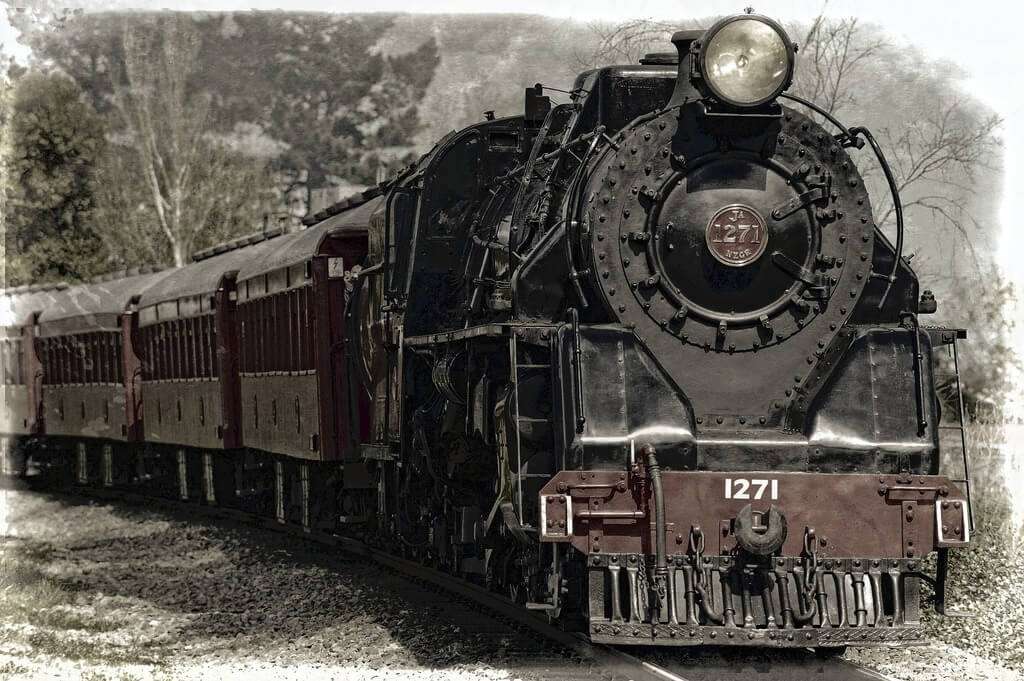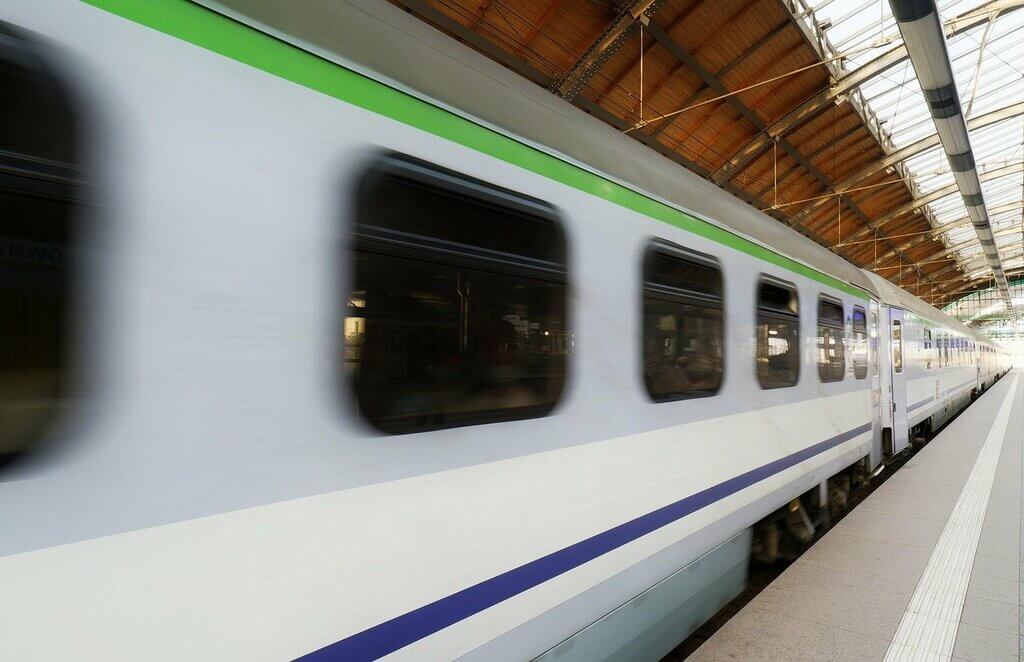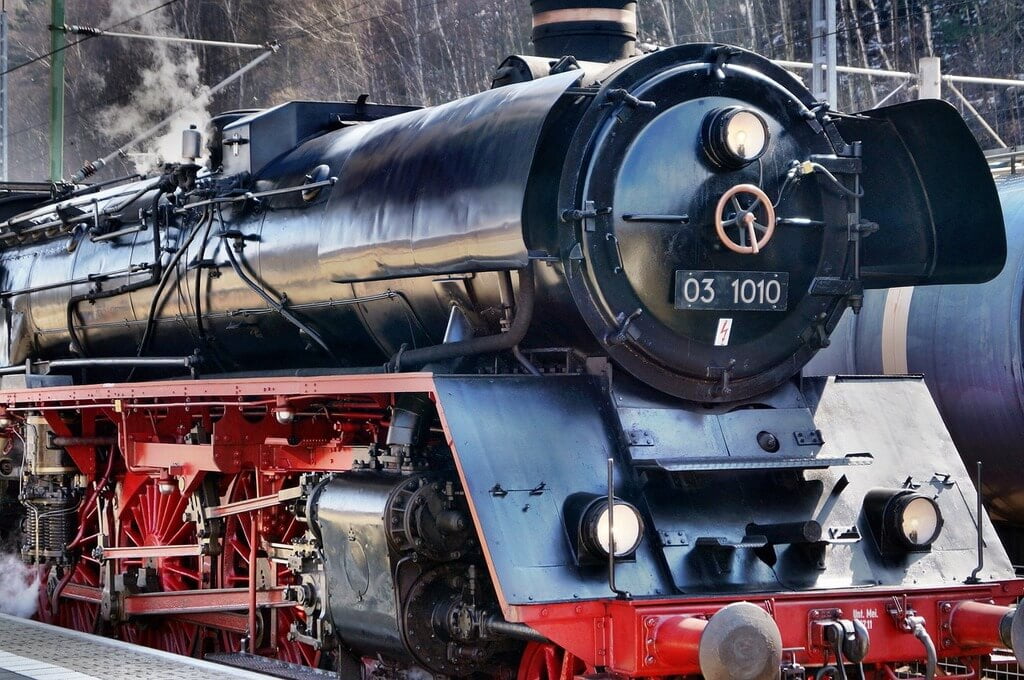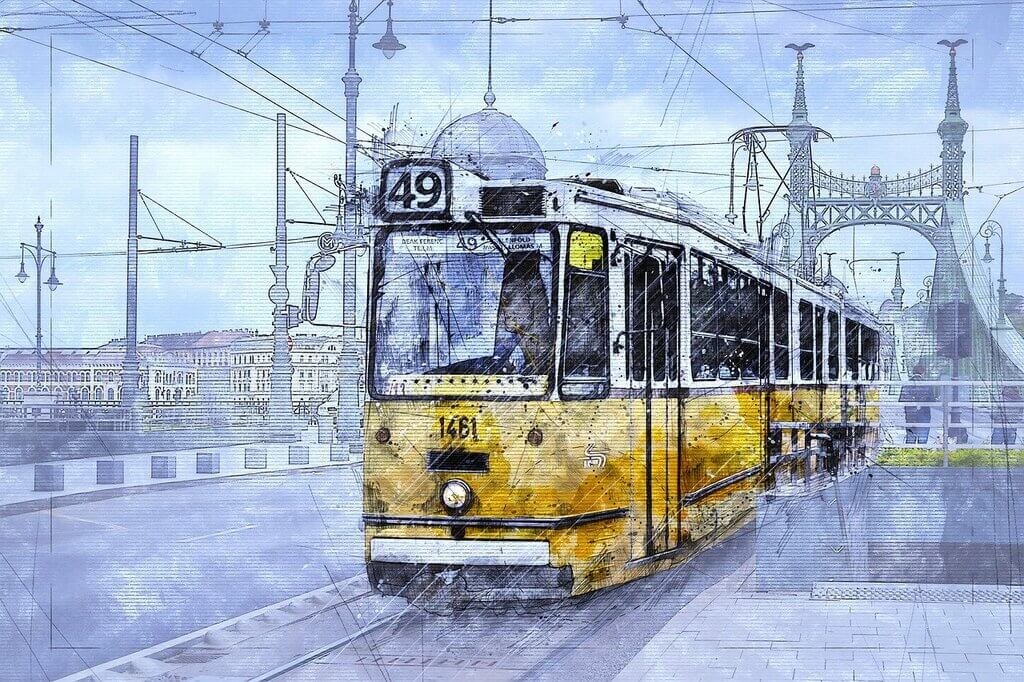The invention of the steam locomotive in the early 19th century revolutionized transportation and profoundly impacted society. Trains, powered by steam engines, brought about faster and more efficient travel and transport. But how far did these early locomotives travel when they were first introduced in the 1800s? In this article, we will explore the development and expansion of trains during this pivotal period in history.

The Birth Of The Steam Locomotive
The birth of the steam locomotive can be traced back to the early 1800s. 1804 British engineer Richard Trevithick built the world’s first working steam locomotive, aptly named the “Puffing Devil.” It was a primitive machine that could haul heavy loads, but its speed and reliability were limited.
When the train was invented by George Stephenson, another British engineer, introduced the “Rocket” in 1829 the concept of the modern locomotive took off. The Rocket was a game-changer, capable of reaching up to 29 miles per hour, a remarkable achievement for its time. With Stephenson’s innovations, the potential for long-distance train travel became apparent.
Early Railroads And Milestones
In the 1830s, the United States and Europe began to see the construction of dedicated railway lines designed for steam locomotives. One of the earliest American railroads was the Baltimore and Ohio (B&O) Railroad, which commenced operations in 1830. This railroad initially connected Baltimore and Ellicott’s Mills (now known as Ellicott City) in Maryland, covering about 13 miles. The B&O marked the beginning of widespread railway development in the United States.
Meanwhile, the Liverpool and Manchester Railway opened in 1830 in England, another significant milestone. This railway covered a distance of 31 miles, making it one of the most extended continuous railway lines at the time. The success of the Liverpool and Manchester Railway played a pivotal role in demonstrating the viability of long-distance train travel.
Expanding Horizons
As the 19th century progressed, trains and railways expanded their reach. Engineers and entrepreneurs saw the potential of railroads as a means of connecting distant cities and regions, and governments began investing in their development. The Transcontinental Railroad, completed in 1869, marked a monumental achievement in the United States. It connected the east and west coasts of the country, spanning a distance of over 1,900 miles.

In Europe, the expansion of railways brought about the ability to travel vast distances in relatively short periods. The Orient Express began operations in 1883, allowing passengers to travel from Paris to Istanbul, covering approximately 1,600 miles. This luxury train service became famous for its comfort and opulence.
The Impact On Society And Commerce
The development of trains and railways in the 1800s profoundly and multifacetedly impacted society and commerce. This section highlights and explains how trains transformed these aspects of human life during that era.
Enhanced Connectivity: Trains significantly improved connectivity between cities, towns, and remote areas. Before the advent of railways, long-distance travel was arduous and time-consuming, often relying on horse-drawn carriages or ships. Trains drastically reduced travel times, making it easier for people to move between regions.
Economic Expansion: Railways were pivotal in fueling economic expansion during the 19th century. They became instrumental in transporting raw materials, manufactured goods, and agricultural products over long distances. This efficiency in transportation lowered costs, encouraged trade, and spurred industrialization.
Urbanization: The growth of railways led to the development of new towns and the expansion of existing cities. Railways provided the means for people to commute from suburbs and rural areas into urban centers for work, thus contributing to the rapid urbanization witnessed during the era.
Job Creation: The construction and operation of railways created a significant number of jobs. From engineers and conductors to laborers and maintenance workers, the railway industry became a significant employer, contributing to reduced unemployment rates.
Standardization: The need for uniformity in railway systems led to the standardization of time zones, tracks, and railway gauges. This standardization ensured safety and influenced the development of global standards in other industries.
Cultural Exchange: Trains facilitated cultural exchange by making travel more accessible to a broader spectrum of society. People from diverse backgrounds could now interact more efficiently, leading to the spread of ideas, culture, and traditions.
Increased Trade: The efficient transportation of goods via trains stimulated domestic and international trade. It allowed for the movement of goods on a larger scale, enabling businesses to reach broader markets and consumers to access a wider variety of products.
Agricultural Revolution: Railways played a pivotal role in the farming revolution by enabling farmers to transport their produce to distant markets quickly. This not only improved farmers’ livelihoods but also led to increased food availability in urban areas.
Tourism And Leisure Travel: Trains made leisure travel more accessible to the middle and working classes. People could now explore new destinations, leading to the development of tourism as an industry. Iconic routes, such as the Orient Express, epitomized the luxury and adventure of train travel.
Technological Advancements: The development of locomotives and railway infrastructure drove engineering and materials science innovations. This, in turn, influenced technological advancements in other industries.

When the train was invented in the 1800s, it traveled far in terms of physical distance and its impact on society and commerce. From the early steam locomotives like the Rocket to the construction of transcontinental railways, trains played a pivotal role in shaping the modern world. They bridged gaps between distant regions, making travel and trade more efficient and accessible. The 19th-century train journey was about miles covered and transforming the world as we knew it.
How Was The Train Used When It Was Invented?
When the train was invented, it marked a pivotal moment in human history, revolutionizing the way people and goods moved across vast distances. The origins of the train can be traced back to the early 19th century when the industrial revolution was underway. In 1804, Richard Trevithick’s pioneering steam locomotive, the “Puffing Devil,” made its inaugural journey in Wales, signaling the birth of the era of steam-powered transportation.
Birth Of A Transportation Marvel
The initial use of the train was primarily for industrial purposes. The invention of the steam engine by James Watt and its subsequent integration into locomotives fueled the development of railway networks, catering to the burgeoning needs of the industrial revolution. These trains were employed to transport raw materials like coal, iron, and other heavy goods, greatly contributing to the rapid expansion of industries.
Revolutionizing Travel And Trade
As technology advanced, trains quickly became an efficient mode of transportation, not only for goods but also for passengers. The development of locomotives and railways offered a faster, more reliable means of travel compared to traditional horse-drawn carriages. People could traverse great distances in significantly less time, altering the dynamics of trade, travel, and ultimately, human connectivity.
The advent of the train not only facilitated the movement of people and goods but also played a pivotal role in unifying nations and cultures. The ability to transport individuals across long distances provided a platform for cultural exchange and the sharing of ideas, fostering societal growth and understanding.
The Expansion Of Railway Networks
The rapid expansion of railway networks was a testament to the train’s versatility and utility. Trains became the lifeline of industrial regions, connecting factories to ports and cities, enabling the swift movement of manufactured goods to markets across the globe.

Railways were meticulously planned and laid out, spanning vast territories and cutting through mountains and valleys. The construction of these networks demanded the labor of thousands and introduced new engineering feats to overcome geographical obstacles.
Impact On Society And Economics
The impact of the train on society and economics cannot be overstated. The train’s ability to transport goods and people more efficiently and at a lower cost stimulated economic growth, fostering the rise of industries and urban centers. This, in turn, created new employment opportunities, attracting people to urban areas and contributing to the evolution of modern cities.
Additionally, the train revolutionized the postal system, enhancing communication by reducing the time it took for mail to reach its destination. This acceleration in communication transformed the way people conducted business and maintained relationships.
Changing The Way People Lived
The advent of the train transformed not only the movement of goods and people but also affected how people lived their daily lives. The accessibility and affordability of train travel made it easier for individuals to explore new places, visit family and friends, and broaden their horizons. Moreover, it led to the standardization of time zones, allowing for more accurate scheduling of train arrivals and departures.
The train brought about changes in social behaviors as well. It shifted the perception of distance, making remote places seem closer and more accessible. This, in turn, encouraged migration and tourism, enriching cultural diversity and understanding.
The Evolution And Legacy Of Trains
As time progressed, the technology behind trains continued to evolve. Steam engines were gradually replaced by diesel and electric locomotives, offering faster speeds, increased efficiency, and reduced environmental impact. High-speed trains emerged, further transforming long-distance travel and trade.

Today, trains continue to play a vital role in transportation. They remain an integral part of the global economy, transporting vast quantities of goods and providing efficient, sustainable modes of travel for millions of people worldwide.
When the train was invented, it not only revolutionized transportation but also sparked a series of profound changes that shaped the world as we know it today. Its impact on industries, economies, societies, and cultures is immeasurable. From its humble beginnings as a steam-powered engine to the high-speed marvels of today, the train’s legacy endures as a testament to human ingenuity and innovation. The journey that began with the invention of the train continues to propel us forward into the future, connecting people and places across the globe.
What Date Was The Train Invented?
Transportation is an essential aspect of human civilization. It has evolved significantly over centuries, from foot travel to the modern innovations of air and space travel. Among the most pivotal advancements in transportation history is the invention of the train. The train’s invention revolutionized the way people and goods moved, connecting distant places and shaping the course of industrial development. But when exactly was the train invented, and how did it come to be?
The Early Stages Of Transportation
Before the train’s inception, human transportation was limited to walking, riding animals, or sailing. Ancient civilizations used rudimentary methods of moving heavy objects, like logs or stones, by rolling or dragging them. However, as societies advanced, the need for faster and more efficient means of transportation became increasingly apparent.
The Birth Of The Train: A Momentous Innovation
The invention of the train was a momentous leap in the history of transportation. When exactly the train was invented might not have a single clear answer, as its development was a result of gradual improvements and innovations over time. Nevertheless, the 19th century is recognized as the era when the train as we know it today came into existence.
The Pioneers Of Railway Systems
In the early 1800s, a significant breakthrough in transportation occurred with the development of steam-powered engines. In 1804, Richard Trevithick, a British engineer, built the first full-scale working railway steam locomotive. This locomotive hauled both passengers and cargo and is considered a crucial step in the development of the modern train. This early steam engine laid the foundation for the expansive railway networks that would emerge in subsequent years.

George Stephenson And The “Rocket”
Another key figure in the history of train invention is George Stephenson. In 1829, Stephenson’s “Rocket” became one of the pioneering steam locomotives, showcasing enhanced speed and efficiency. This steam engine was a significant leap forward in railway technology and laid down the principles for subsequent locomotive designs.
The Growth Of Railways: A Global Phenomenon
The advent of the train triggered a massive revolution in transportation across the globe. The construction of railway networks expanded rapidly, connecting cities and industries and spurring economic development. By the mid-19th century, various countries had established extensive railway systems, allowing faster and more convenient movement of people and goods over long distances.
Impact On Industrialization And Society
The train’s invention had a profound impact on industrialization and society. It facilitated the transportation of raw materials and finished goods, fostering the growth of industries and trade. This mass movement of goods and people transformed urban centers and encouraged the development of new communities along railway lines.
Advancements In Train Technology
The evolution of trains did not stop with the invention of steam-powered locomotives. Technological advancements led to the creation of diesel and electric trains, further enhancing speed, efficiency, and sustainability. High-speed trains, maglev trains, and other modern innovations continue to redefine what was once deemed impossible in the realm of transportation.
When The Train Was Invented: A Reflection
The precise moment when the train was invented may not be confined to a single date or event. Instead, it was a culmination of the efforts of various inventors and engineers over time. The transformation of transportation from simple animal-drawn carts to high-speed electric trains is an ongoing journey, continually shaped by innovation and human ingenuity.

The Legacy Of The Train
The legacy of the train’s invention is undeniable. It not only revolutionized transportation but also influenced culture, art, and literature. Trains became symbols of progress and adventure, inspiring countless stories and artistic expressions, and capturing the imagination of people across the globe.
Final Thoughts
The train’s invention is an integral chapter in the story of human progress. It reshaped societies, connected distant places, and fueled industrial growth. Although pinpointing the exact date when the train was invented might be elusive due to its gradual development, its impact on civilization remains unquestionable. The evolution of the train continues to be a testament to humanity’s quest for innovation and a reminder of the incredible journey from the locomotives of the past to the high-speed trains of the present day.
Also Read: How Did The Invention Of Trains Change The World?
